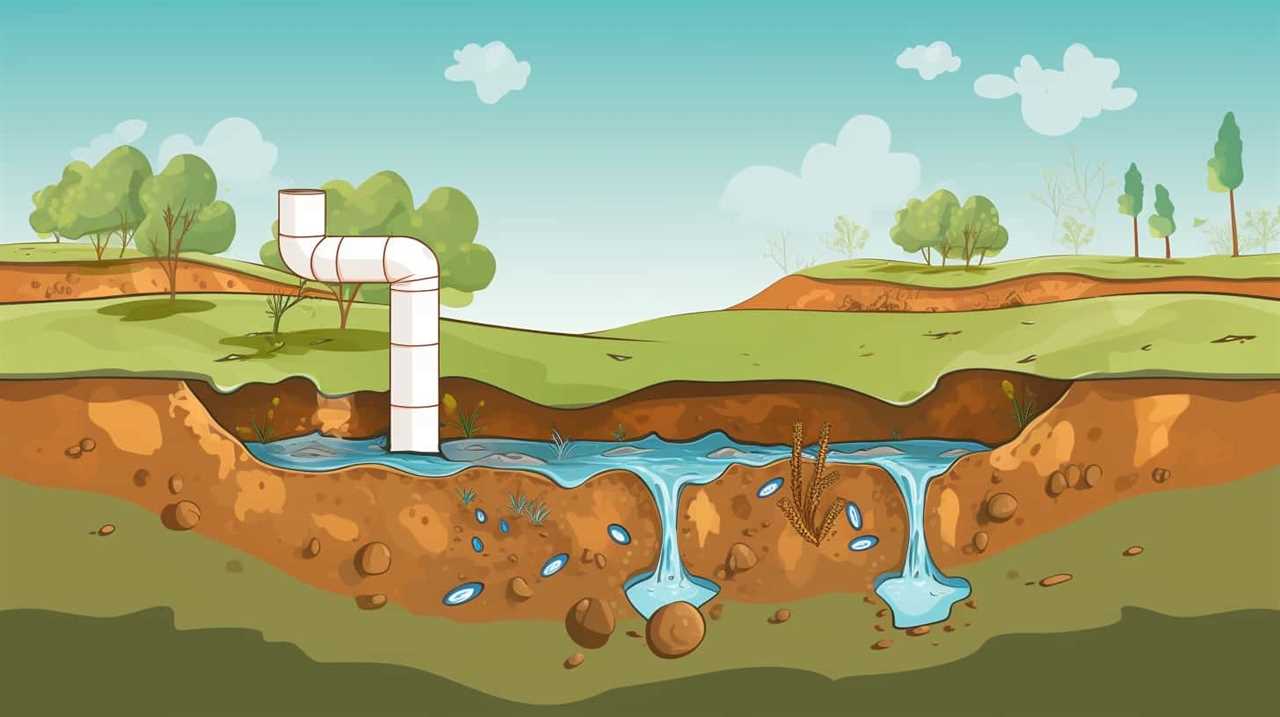Many of us have pondered why our bathroom has a sewer-like odor. Allow us to shed some light on the issue with a bit of technical insight.
The truth is, there are a few common causes behind this unpleasant odor. It could be a faulty toilet seal, clogged vent pipes, a dry P-trap in the sink or shower, or even issues with the sewer line.
In this article, we’ll dive into each of these possibilities to help you master the art of eliminating that sewer smell.
Key Takeaways
- Proper ventilation, such as using an exhaust fan or opening windows, is crucial to prevent sewer smell in the bathroom.
- Regular cleaning and maintenance, including cleaning the toilet, sink, and drains, and checking for plumbing issues, help eliminate unpleasant odors.
- A faulty toilet seal, indicated by persistent sewer smell and water pooling around the toilet base, can contribute to the sewer smell.
- Clogged or blocked vent pipes, which can be caused by debris like dirt or bird nests, can allow unpleasant odors to escape into the bathroom. Regular inspection and cleaning of vent pipes are necessary to prevent sewer smell.
Common Causes of Sewer Smell in Bathrooms
In the article, we’ll explore the common causes of sewer smell in bathrooms.

One of the primary culprits for this unpleasant odor is improper bathroom ventilation. When a bathroom lacks proper ventilation, it creates a stagnant environment where odors can accumulate. To prevent sewer smell, it’s crucial to ensure adequate airflow by installing an exhaust fan or opening windows during and after using the bathroom.
Additionally, regular cleaning and maintenance play a vital role in preventing sewer smell. Regularly cleaning the bathroom, including the toilet, sink, and drains, removes any potential sources of odor. It’s also essential to check for leaks or cracks in plumbing fixtures and promptly address them to prevent sewer gas from entering the bathroom.
Faulty Toilet Seal
Moving on from the common causes of sewer smell in bathrooms, another issue that can contribute to the unpleasant odor is a faulty toilet seal. A faulty toilet seal occurs when the wax ring or rubber gasket that seals the toilet to the floor becomes worn out or damaged. This can result in sewage gases leaking into the bathroom, causing a foul smell. To identify if you have a faulty toilet seal, there are a few signs to look out for. Firstly, if you notice a persistent sewer smell in your bathroom, even after cleaning, it could be a sign of a faulty seal. Additionally, if you see water pooling around the base of the toilet or notice any sagging or movement when you sit on the toilet, it may be time for a toilet seal replacement.
| Signs of a Faulty Toilet Seal | ||
|---|---|---|
| Persistent sewer smell | Water pooling around toilet base | Sagging or movement when sitting on toilet |
Clogged or Blocked Vent Pipes
Our bathroom smells like sewer because of clogged or blocked vent pipes.

Vent pipes play a crucial role in plumbing systems by allowing air to circulate and equalize pressure.
When these pipes become clogged or blocked, the air can’t flow freely, causing unpleasant odors to escape into the bathroom.
The accumulation of debris, such as dirt, leaves, or even bird nests, can obstruct the vent pipes and hinder their proper functioning.
To resolve this issue, it’s essential to perform regular plumbing maintenance. This maintenance should include inspecting and cleaning the vent pipes to ensure they remain clear and unobstructed.

Dry P-Trap in Sink or Shower
We often encounter a dry P-trap in our sink or shower, which can contribute to the sewer-like smell in our bathroom. The P-trap is a U-shaped pipe that prevents sewer gases from entering our living space. It works by creating a water seal that blocks the gases from escaping. However, if the P-trap dries out due to infrequent use or plumbing leaks, it loses its effectiveness, allowing the unpleasant smell to permeate our bathroom.
To better understand the impact of a dry P-trap, let’s take a look at the following table:
| Issue | Cause | Solution |
|---|---|---|
| Mold growth | Moisture in the P-trap evaporates | Run water regularly to keep the trap filled |
| Plumbing leaks | Cracks or loose connections in the P-trap | Repair or replace the faulty components |
Sewer Line Issues
Continuing from the previous section, let’s now address the potential sewer line issues that may contribute to the unpleasant odor in our bathroom.
Sewer line problems can cause foul smells to waft into our bathroom, indicating the need for sewer line repair or professional plumbing services.

One common issue is a cracked or broken sewer line, which allows sewage gas to escape and create an unpleasant odor.
Another problem could be a clogged sewer line, obstructing the flow of wastewater and causing it to back up into the bathroom.
Additionally, tree roots can infiltrate and damage sewer lines, leading to leaks and odors.
It’s crucial to address these sewer line issues promptly by seeking professional plumbing services to prevent further damage and eliminate the foul smell from our bathroom.

Frequently Asked Questions
How Can I Tell if the Sewer Smell in My Bathroom Is Caused by a Faulty Toilet Seal?
To determine if a faulty toilet seal is causing the sewer smell in our bathroom, we should conduct a thorough toilet seal inspection. Common causes of sewer smells include cracked seals or improper installation.
Is It Possible for Clogged or Blocked Vent Pipes to Cause a Sewer Smell in the Bathroom, Even if the Toilet Is Functioning Properly?
Yes, clogged vent pipes can cause a sewer smell in the bathroom, even with a functioning toilet. However, it’s also important to check for a faulty toilet seal as it can be another potential cause.
Can a Dry P-Trap in the Sink or Shower Be the Sole Cause of a Sewer Smell in the Bathroom, or Are There Other Factors That Can Contribute to It?
A dry p-trap in the sink or shower can indeed be the sole cause of a sewer smell in the bathroom. However, other factors, such as clogged vent pipes, can also contribute to this unpleasant odor.
Are There Any Warning Signs or Symptoms That Indicate a Potential Issue With the Sewer Line, Aside From the Bathroom Smelling Like Sewer?
Warning signs of a potential sewer line issue can include slow drainage, gurgling sounds, and water backups in multiple fixtures. Additionally, identifying a faulty toilet seal without relying on the sewer smell involves inspecting for water leaks around the base.

What Steps Can I Take to Prevent Sewer Line Issues and Avoid a Foul Smell in the Bathroom?
To prevent sewer line issues and avoid a foul smell in the bathroom, we can take preventive measures such as regular maintenance, avoiding flushing non-biodegradable items, and ensuring proper ventilation. Common causes include clogs, leaks, and inadequate plumbing traps.
Conclusion
In conclusion, when experiencing a foul sewer smell in your bathroom, it’s crucial to identify and address the underlying causes promptly.
Faulty toilet seals, clogged vent pipes, dry P-traps in sinks or showers, and sewer line issues are common culprits that require attention.
By resolving these issues, you can eliminate the unpleasant odor and ensure a clean and fresh bathroom environment.

Remember, a well-functioning plumbing system is the key to a pleasant and odor-free bathroom experience.










